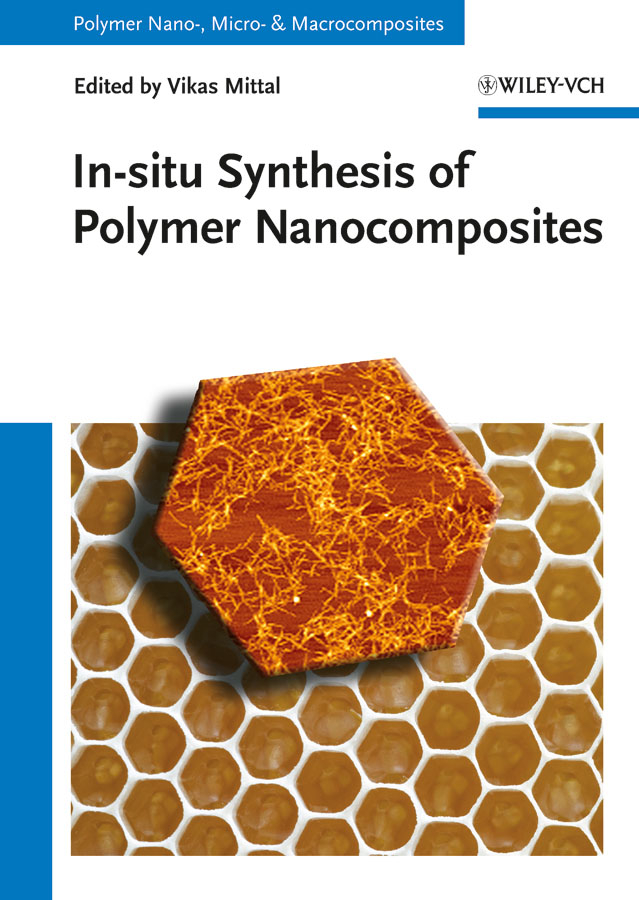
This book familiarizes readers with the proven strategies -- as well as the pitfalls -- involved in successfully synthesizing the different types of composites together with their various demands concerning the processing conditions and other influencing factors. Following an overview of the synthesis methodologies, the text goes on to discuss the most relevant polymer materials, including polyamides, polyolefines, polyacrylates, polyethylenes, polyurethanes, polyesters and polyepoxides. INDICE: Preface XIII List of Contributors XV 1 In-situ Synthesis of Polymer Nanocomposites 1 Vikas Mittal 1.1 Introduction 1 1.2 Synthesis Methods 9 1.3In-situ Synthesis of Polymer Nanocomposites 12 References 24 2 Polyamide Nanocomposites by In-situ Polymerization 27 Anastasia C. Boussia, Stamatina N. Vouyiouka, and Constantine D. Papaspyrides 2.1 Introduction 27 2.2 Manufacturing Processes of Commercially Important Polyamides 29 2.2.1 Poly(caproamide) (PA 6) 29 2.2.2 Poly(hexamethylene adipamide) (PA 6.6) 30 2.2.3 Low-Temperature Polymerization Processes 31 2.3 Polyamide Nanocomposites 34 2.3.1 Introduction 342.3.2 Lactam/Amino Acid-Based In-situ Intercalated PA Nanocomposites 36 2.3.3Diamine- and Diacid-Based In-situ Intercalated PA Nanocomposites 41 2.3.3.1 Solution-Melt Polymerization Technique 41 2.3.3.2 Anhydrous Melt PolymerizationTechnique 43 2.3.3.3 Direct SSP Technique 44 2.3.3.4 Interfacial Polycondensation Technique 46 2.4 Conclusions 48 References 49 3 PolyolefinClay Nanocomposites by In-situ Polymerization 53 Abolfazl Maneshi, João Soares, and Leonardo Simon 3.1 Introduction 53 3.2 Clays 54 3.2.1 General Structure 54 3.2.2 Smectites 54 3.2.3 Clay Particle Morphological Hierarchy 56 3.2.4 Clay Chemical Reactions 58 3.2.4.1 Cation Exchange Reactions 58 3.2.4.2 Interaction with OrganicCompounds 58 3.3 In-situ Polymerization of Olefins with Coordination Catalysts Supported on Clays 59 3.3.1 Olefi n Polymerization with Coordination Catalysts 60 3.3.2 Polymerization Mechanism with Coordination Catalysts 60 3.3.3 Coordination Catalysts for in In-situ Polymerization 62 3.3.4 Catalyst Supporting 63 3.3.4.1 Catalyst Supporting Methods 63 3.3.5 Clay Surface Modification Methods for In-situ Polymerization 64 3.3.5.1 Organic Modification 64 3.3.5.2 Thermal Treatment 66 3.3.5.3 Treatment with Alkylaluminum Compounds 66 3.3.6 Particle Break-Up and Exfoliation 67 3.3.7 In-situ Polymerization Approaches 69 3.3.7.1 Clay as a Polymerization Additive 71 3.3.7.2 Clay as a Polymerization Catalyst Support 72 3.3.7.3 Clay as an Activator for Polymerization Catalysts 74 3.3.7.4 In-situ Production of Alkylaluminoxanes 76 3.3.7.5 Other Techniques 763.3.8 Factors Determining the Success of In-situ Polymerization 78 3.3.8.1 Clay Type 78 3.3.8.2 Swellability 79 3.3.8.3 Effect of Clay Surface Treatment 803.3.8.4 Catalyst : Clay Ratio 81 3.3.8.5 Effect of Polymerization Conditions 82 3.3.9 Clay Effect on the Polymerization Behavior and Polymer Molecular Structure 83 3.3.10 Future Approaches 84 References 85 4 Gas-Phase-Assisted Surface Polymerization and Thereby Preparation of Polymer Nanocomposites 89 Haruo Nishida, Yoshito Andou, and Takeshi Endo 4.1 Introduction 89 4.2 In-situ Polymerization for Nanocomposite Preparation 89 4.3 Characteristics of GASP 91 4.3.1 Thin Layer Coating of Solid-Substrate Surfaces 91 4.3.2 Physically Controlled Polymerization Behavior 92 4.3.3 Photo-Induced Controlled Polymerization 93 4.4 Composite Preparation by GASP 95 4.4.1 Poly
- ISBN: 978-3-527-32879-6
- Editorial: Wiley-VCH
- Encuadernacion: Cartoné
- Páginas: 418
- Fecha Publicación: 16/11/2011
- Nº Volúmenes: 1
- Idioma: Inglés
